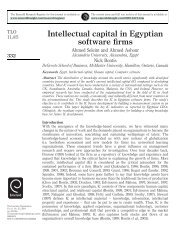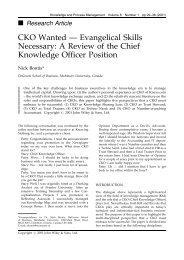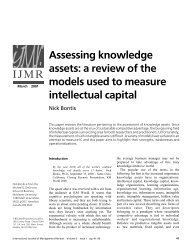A scientometric analysis of knowledge management and ... - Emerald
A scientometric analysis of knowledge management and ... - Emerald
A scientometric analysis of knowledge management and ... - Emerald
Create successful ePaper yourself
Turn your PDF publications into a flip-book with our unique Google optimized e-Paper software.
the research arena becomes dominated by only a few scientific elite nations. Unfortunately,<br />
the Matthew effect for countries also appears in KM/IC.<br />
Implication V: the comparison <strong>of</strong> most productive countries, institutions <strong>and</strong> individuals with<br />
those reported by Serenko <strong>and</strong> Bontis (2004)<br />
In this study, the top 30 most productive countries, institutions <strong>and</strong> individuals were<br />
identified. These findings were compared with those reported by Serenko <strong>and</strong> Bontis (2004).<br />
Recall that Serenko <strong>and</strong> Bontis analyzed only three KM/IC outlets:<br />
1. Journal <strong>of</strong> Knowledge Management;<br />
2. Journal <strong>of</strong> Intellectual Capital; <strong>and</strong><br />
3. Knowledge <strong>and</strong> Process Management.<br />
First, the same countries were included in both top five lists. Spain, however, increased its<br />
output <strong>and</strong> moved from the fifth to the fourth place, leaving Canada behind. Out <strong>of</strong> the top 30<br />
countries ranked in the present project, only three (Italy, Taiwan <strong>and</strong> Austria) did not appear<br />
in Serenko <strong>and</strong> Bontis’s top 30 list. Second, even though Cranfield University topped both<br />
lists, differences in institutional top 30 rankings were observed. As such, 16 new institutions<br />
appeared. Third, in the list <strong>of</strong> the leading 30 scholars, 20 new names appeared. Overall, this<br />
demonstrates that the selection <strong>of</strong> target journals <strong>and</strong> time frame has little impact on national<br />
rankings; however, it dramatically affects institutional <strong>and</strong> individual top lists.<br />
Implication VI: productivity scores obtained by author position, direct count, <strong>and</strong> equal credit<br />
methods depend on the level <strong>of</strong> <strong>analysis</strong> (i.e. country, institution or individual)<br />
Based on the comparison <strong>of</strong> three different productivity score calculation methods, the<br />
following observations were made. First, for countries, all three methods produced almost<br />
identical results. Second, equal credit <strong>and</strong> author position techniques generated similar<br />
productivity scores regardless <strong>of</strong> the level <strong>of</strong> <strong>analysis</strong> (i.e. country, institution or individual).<br />
Third, there was a positive relationship between the degree <strong>of</strong> data aggregation <strong>and</strong><br />
consistency <strong>of</strong> the productivity scores obtained by these methods. In other words, when the<br />
productivity scores were combined at the institutional or national levels, these three<br />
approaches <strong>of</strong>fered more consistent results. Note that the author position technique is very<br />
laborious <strong>and</strong> error-prone. Therefore, it may be fully eliminated in favor <strong>of</strong> direct count or<br />
equal credit methods. It is also concluded that the direct count technique, which is very<br />
simple to perform, may be successfully utilized in cases <strong>of</strong> national productivity rankings.<br />
Implication VII: there are many KM/IC authors, especially practitioners, who contributed only<br />
once to the body <strong>of</strong> <strong>knowledge</strong><br />
With respect to Lotka’s law, the value <strong>of</strong> n was found to be 2.82. This is higher than what is<br />
proposed by Lotka (n ¼ 2) because a large proportion <strong>of</strong> all authors (80 percent) published<br />
only a single work in the outlets examined in the present investigation. This phenomenon<br />
took place because <strong>of</strong> the high number <strong>of</strong> practitioners who contributed only once (89<br />
percent). In fact, since it is not the sole or key duty <strong>of</strong> non-academics to produce research,<br />
they are likely to contribute less frequently than academics. However, given that the overall<br />
contribution <strong>of</strong> practitioners has been gradually declining, it is likely that future authors within<br />
the field <strong>of</strong> KM/IC will eventually be represented by academics with higher publication<br />
frequencies. Therefore, the overall proportion <strong>of</strong> all authors with only a single work will<br />
decline, thereby bringing the value <strong>of</strong> n closer to 2 as theorized by Lotka.<br />
Implication VIII: scholarly KM/IC output may potentially contribute to the wealth <strong>of</strong> nations<br />
During this study, a number <strong>of</strong> smaller, very productive countries were discovered. The<br />
strong attention <strong>of</strong> smaller nations to KM/IC topics suggests that KM/IC may potentially <strong>of</strong>fer<br />
a competitive advantage <strong>and</strong> help develop <strong>knowledge</strong>-intensive economies. It is noted that<br />
most <strong>of</strong> these countries are non-English speaking. At the same time, their academics have<br />
dramatically contributed to the KM/IC body <strong>of</strong> research published in English-language<br />
journals. Therefore, it is likely that these authors also published KM/IC works in non-English<br />
PAGE 18j j JOURNAL OF KNOWLEDGE MANAGEMENT VOL. 14 NO. 1 2010








